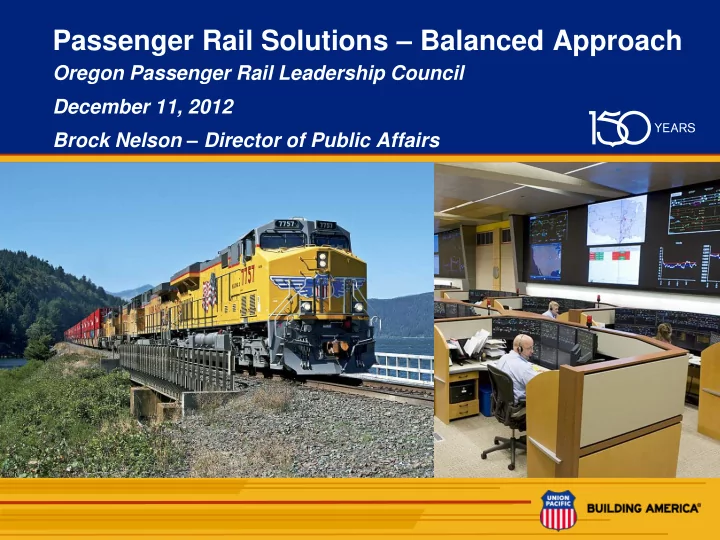

Passenger Rail Solutions – Balanced Approach Oregon Passenger Rail Leadership Council December 11, 2012 Brock Nelson – Director of Public Affairs 1 1
Union Pacific System Seattle Eastport Portland Duluth Twin Cities Chicago Omaha SLC Oakland 2011 Fast Facts (Year End) KC Denver • Operating St. Louis Revenue $19.6 B • Route Miles 32,000 in LA Memphis 23 States Calexico Dallas • Employees 45,000 New Nogales El Paso Orleans • Annual Payroll $4.0 B Houston Eagle Pass • Customers 25,000 Laredo • Locomotives Brownsville 8,200 2 2
Union Pacific in Oregon 2011 Fast Facts Miles of Track 1,073 Annual Payroll $126.6 M In-State Purchases $159.1 M Capital Spending $132.1 M Employees 1,592 Community Giving $308,609 3 3
Both Passenger & Freight Solutions Required • Communities want passenger rail transportation to . . . – Reduce traffic congestion – Avoid/reduce road construction and maintenance – Provide answer to future capacity needs • Communities depend on freight rail transportation to . . . – Supply the goods they use everyday (food, vehicles, energy) – Reduce dependency on foreign oil through its fuel efficiency – Lower emissions by two thirds – Reduce highway congestion – Make products affordable by means of cost-effective shipping – Support infrastructure with private funds – not taxpayer dollars 4 4
Long-Term Demand for Freight Transportation Will Skyrocket Billions of Tons of Freight Transported in the U.S. U.S. DOT projection 5 5
Expected Rail Traffic vs. Rail Capacity Today 2035 Without Improvements Below capacity Near capacity At capacity Above capacity 6 6
Railroads Already Spend More Than Most State Highway Agencies! $ in Billions 1. California $7.16 2. Texas $6.50 Class I Railroad 3. $5.27 Florida 4. Pennsylvania $4.66 Spending* on $4.27 Union Pacific Infrastructure $4.27 BNSF vs. 5. New York $3.93 State Highway Agency 6. Illinois $3.43 7. Louisiana $3.20 Spending* - 2008 8. North Carolina $2.60 Norfolk Southern $2.53 $2.52 CSX 9. Washington $2.49 *Capital outlays plus maintenance expenses. 2009. 10. Michigan $2.45 Sources: FHWA Highway Statistics; AAR 7 7
Principles for Achieving Appropriate Balance • Safe commuter and freight operations • Reliable service for passengers and freight customers • Protect capacity to accommodate future freight traffic growth • Market-based compensation and no additional exposure to liability 8 8
Union Pacific Participates in Passenger Rail Commuter Trains on UP • Each weekday: 250 trains and 126,000 passengers By comparison, Amtrak operates 300 trains with 83,000 daily passengers – • Examples: – Chicago Metra (UP operates commuter trains on three routes; USA’s 7 th largest commuter operation) – Altamont Commuter Express (Stockton – San Jose, CA) – CALTRAIN (San Jose – Gilroy, CA) – Metrolink (LA - Riverside, CA & Moorpark - Montalvo, CA) Amtrak on UP • 76 trains and 17,000 daily passengers • Example: – Capital Corridor Service (San Jose – Oakland – Sacramento – Auburn; 32 daily trains) 9 9
Working Together to Meet Customers’ Needs for Passenger and Freight • UP is willing to discuss passenger rail proposals • Safety must be priority – Separate track/right-of-way preferable – Positive Train Control systems must be present – Commuter agencies must meet all UP and FRA safety standards and fund all incremental safety requirements • Freight service must not be compromised – Including UP’s ability to expand, operate on demand, service existing customers and locate new customers • Commuter growth capacity must be funded by commuter agency and freight growth capacity must be protected • Commuter agencies must indemnify/protect UP against all liability • Commuter agencies must pay all costs: developing proposals, return on UP assets/property, UP tax liability, etc. 10 10
Thank you ! 11 11
Recommend
More recommend